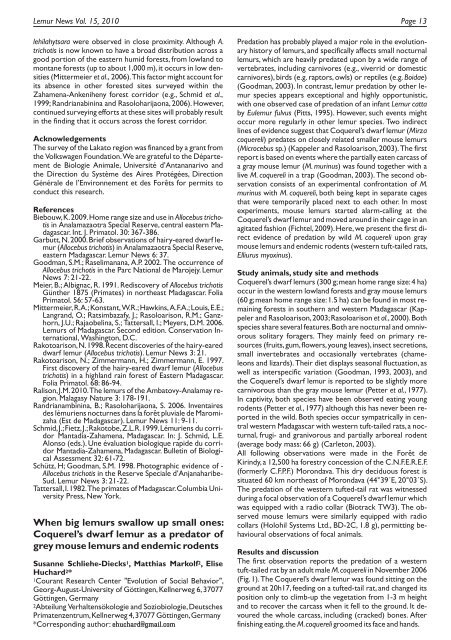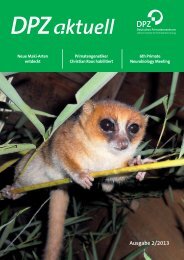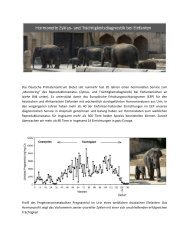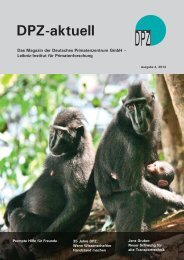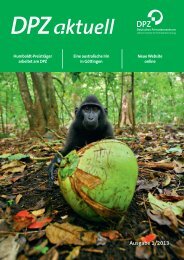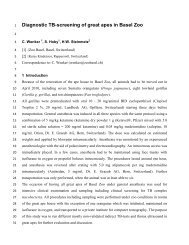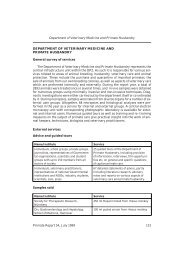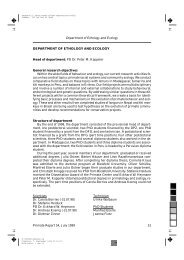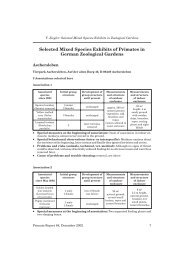Vol. 15 - Deutsches Primatenzentrum
Vol. 15 - Deutsches Primatenzentrum
Vol. 15 - Deutsches Primatenzentrum
Create successful ePaper yourself
Turn your PDF publications into a flip-book with our unique Google optimized e-Paper software.
Lemur News <strong>Vol</strong>. <strong>15</strong>, 2010 Page 13<br />
lehilahytsara were observed in close proximity. Although A.<br />
trichotis is now known to have a broad distribution across a<br />
good portion of the eastern humid forests, from lowland to<br />
montane forests (up to about 1,000 m),it occurs in low densities<br />
(Mittermeier et al., 2006).This factor might account for<br />
its absence in other forested sites surveyed within the<br />
Zahamena-Ankeniheny forest corridor (e.g., Schmid et al.,<br />
1999; Randrianabinina and Rasoloharijaona, 2006). However,<br />
continued surveying efforts at these sites will probably result<br />
in the finding that it occurs across the forest corridor.<br />
Acknowledgements<br />
The survey of the Lakato region was financed by a grant from<br />
the <strong>Vol</strong>kswagen Foundation.We are grateful to the Département<br />
de Biologie Animale, Université d’Antananarivo and<br />
the Direction du Système des Aires Protégées, Direction<br />
Générale de l’Environnement et des Forêts for permits to<br />
conduct this research.<br />
References<br />
Biebouw,K.2009.Home range size and use in Allocebus trichotis<br />
in Analamazaotra Special Reserve, central eastern Madagascar.<br />
Int. J. Primatol. 30: 367-386.<br />
Garbutt,N.2000.Brief observations of hairy-eared dwarf lemur<br />
(Allocebus trichotis) in Analamazaotra Special Reserve,<br />
eastern Madagascar. Lemur News 6: 37.<br />
Goodman, S.M.; Raselimanana, A.P. 2002. The occurrence of<br />
Allocebus trichotis in the Parc National de Marojejy. Lemur<br />
News 7: 21-22.<br />
Meier, B.; Albignac, R. 1991. Rediscovery of Allocebus trichotis<br />
Günther 1875 (Primates) in northeast Madagascar. Folia<br />
Primatol. 56: 57-63.<br />
Mittermeier,R.A.;Konstant,W.R.;Hawkins,A.F.A.;Louis,E.E.;<br />
Langrand, O.; Ratsimbazafy, J.; Rasoloarison, R.M.; Ganzhorn,<br />
J.U.; Rajaobelina, S.; Tattersall, I.; Meyers, D.M. 2006.<br />
Lemurs of Madagascar. Second edition. Conservation International,<br />
Washington, D.C.<br />
Rakotoarison,N.1998.Recent discoveries of the hairy-eared<br />
dwarf lemur (Allocebus trichotis). Lemur News 3: 21.<br />
Rakotoarison, N.; Zimmermann, H.; Zimmermann, E. 1997.<br />
First discovery of the hairy-eared dwarf lemur (Allocebus<br />
trichotis) in a highland rain forest of Eastern Madagascar.<br />
Folia Primatol. 68: 86-94.<br />
Ralison,J.M.2010.The lemurs of the Ambatovy-Analamay region.<br />
Malagasy Nature 3: 178-191.<br />
Randrianambinina, B.; Rasoloharijaona, S. 2006. Inventaires<br />
des lémuriens nocturnes dans la forêt pluviale de Maromizaha<br />
(Est de Madagascar). Lemur News 11: 9-11.<br />
Schmid,J.;Fietz,J.;Rakotobe,Z.L.R.1999.Lémuriens du corridor<br />
Mantadia-Zahamena, Madagascar. In: J. Schmid, L.E.<br />
Alonso (eds.). Une évaluation biologique rapide du corridor<br />
Mantadia-Zahamena, Madagascar. Bulletin of Biological<br />
Assessment 32: 61-72.<br />
Schütz, H; Goodman, S.M. 1998. Photographic evidence of -<br />
Allocebus trichotis in the Reserve Speciale d’Anjanaharibe-<br />
Sud. Lemur News 3: 21-22.<br />
Tattersall,I.1982.The primates of Madagascar.Columbia University<br />
Press, New York.<br />
When big lemurs swallow up small ones:<br />
Coquerel’s dwarf lemur as a predator of<br />
grey mouse lemurs and endemic rodents<br />
Susanne Schliehe-Diecks 1, Matthias Markolf 2, Elise<br />
Huchard 2*<br />
1Courant Research Center "Evolution of Social Behavior",<br />
Georg-August-University of Göttingen,Kellnerweg 6,37077<br />
Göttingen, Germany<br />
2Abteilung Verhaltensökologie and Soziobiologie,<strong>Deutsches</strong><br />
<strong>Primatenzentrum</strong>,Kellnerweg 4,37077 Göttingen,Germany<br />
*Corresponding author: ehuchard@gmail.com<br />
Predation has probably played a major role in the evolutionary<br />
history of lemurs, and specifically affects small nocturnal<br />
lemurs, which are heavily predated upon by a wide range of<br />
vertebrates, including carnivores (e.g., viverrid or domestic<br />
carnivores), birds (e.g. raptors, owls) or reptiles (e.g. Boidae)<br />
(Goodman, 2003). In contrast, lemur predation by other lemur<br />
species appears exceptional and highly opportunistic,<br />
with one observed case of predation of an infant Lemur catta<br />
by Eulemur fulvus (Pitts, 1995). However, such events might<br />
occur more regularly in other lemur species. Two indirect<br />
lines of evidence suggest that Coquerel’s dwarf lemur (Mirza<br />
coquereli) predates on closely related smaller mouse lemurs<br />
(Microcebus sp.) (Kappeler and Rasoloarison,2003).The first<br />
report is based on events where the partially eaten carcass of<br />
a gray mouse lemur (M. murinus) was found together with a<br />
live M. coquereli in a trap (Goodman, 2003). The second observation<br />
consists of an experimental confrontation of M.<br />
murinus with M. coquereli, both being kept in separate cages<br />
that were temporarily placed next to each other. In most<br />
experiments, mouse lemurs started alarm-calling at the<br />
Coquerel’s dwarf lemur and moved around in their cage in an<br />
agitated fashion (Fichtel,2009).Here,we present the first direct<br />
evidence of predation by wild M. coquereli upon gray<br />
mouse lemurs and endemic rodents (western tuft-tailed rats,<br />
Elliurus myoxinus).<br />
Study animals, study site and methods<br />
Coquerel’s dwarf lemurs (300 g;mean home range size:4 ha)<br />
occur in the western lowland forests and gray mouse lemurs<br />
(60 g;mean home range size:1.5 ha) can be found in most remaining<br />
forests in southern and western Madagascar (Kappeler<br />
and Rasoloarison,2003;Rasoloarison et al.,2000).Both<br />
species share several features.Both are nocturnal and omnivorous<br />
solitary foragers. They mainly feed on primary resources<br />
(fruits,gum,flowers,young leaves),insect secretions,<br />
small invertebrates and occasionally vertebrates (chameleons<br />
and lizards). Their diet displays seasonal fluctuation, as<br />
well as interspecific variation (Goodman, 1993, 2003), and<br />
the Coquerel’s dwarf lemur is reported to be slightly more<br />
carnivorous than the gray mouse lemur (Petter et al., 1977).<br />
In captivity, both species have been observed eating young<br />
rodents (Petter et al., 1977) although this has never been reported<br />
in the wild. Both species occur sympatrically in central<br />
western Madagascar with western tuft-tailed rats,a nocturnal,<br />
frugi- and granivorous and partially arboreal rodent<br />
(average body mass: 66 g) (Carleton, 2003).<br />
All following observations were made in the Forêt de<br />
Kirindy,a 12,500 ha forestry concession of the C.N.F.E.R.E.F.<br />
(formerly C.F.P.F.) Morondava. This dry deciduous forest is<br />
situated 60 km northeast of Morondava (44°39´E, 20°03´S).<br />
The predation of the western tufted-tail rat was witnessed<br />
during a focal observation of a Coquerel’s dwarf lemur which<br />
was equipped with a radio collar (Biotrack TW3). The observed<br />
mouse lemurs were similarly equipped with radio<br />
collars (Holohil Systems Ltd., BD-2C, 1.8 g), permitting behavioural<br />
observations of focal animals.<br />
Results and discussion<br />
The first observation reports the predation of a western<br />
tuft-tailed rat by an adult male M.coquereli in November 2006<br />
(Fig.1).The Coquerel’s dwarf lemur was found sitting on the<br />
ground at 20h17, feeding on a tufted-tail rat, and changed its<br />
position only to climb-up the vegetation from 1-3 m height<br />
and to recover the carcass when it fell to the ground. It devoured<br />
the whole carcass, including (cracked) bones. After<br />
finishing eating,the M.coquereli groomed its face and hands.


